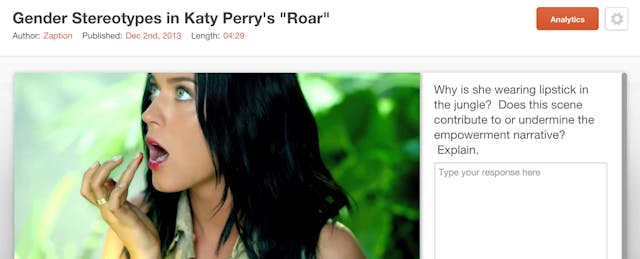When students watch instructional videos, how much do they remember—and how much goes in one ear and out the other?
With a $1.5 million seed round from NewSchools Venture Fund, Redcrest Enterprises, Telegraph Hill Capital and others, San Francisco, CA-based Zaption hopes to answer that question. Zaption also announced $1 million raised through Small Business Innovation Research (SBIR) grants from the US Department of Education, including a grant to build interactive science lessons for high school students in partnership with Discovery Education.
“Everyone loves to use video for learning, but there isn’t a lot of research saying that it makes a difference,” CEO Chris Walsh tells EdSurge. By enabling users to add text, images, and other annotations, Zaption aspires to “turn video from a passive to an active viewing experience.”
Zaption’s software operates on a freemium model. In the free version, users can add six interactive elements—image slide, drawing, open response, multiple choice, branching, and numerical response—to videos. In the pro version, educators can access additional features, including a discussion board and drawn responses. Instructors can buy the upgrade individually for $89/year, and schools or districts can purchase a campus-level pro subscription for 15 or more instructors and their students starting at $995/year. All users can access Zaption’s free online gallery of customizable videos.
Walsh also emphasizes that Zaption, which won the "Mindful Data" Digital Innovation in Learning Award in 2014, collects and provides data to educators. On a dashboard, teachers can see how much of a lesson each student has watched and completed, and how well each student has performed on comprehension questions, both as individual data points and a class aggregate.
In fall 2014, Zaption expanded to offer a second service: video teacher training modules. “In addition to selling [Zaption] as a content creation tool, we also make and build content for teacher training organizations on the platform, including PARCC, WestEd, and the Carnegie Center for Advancement of Teaching,” Walsh explains.
Since it was founded by father-and-son team Jim and Charlie Stigler back in 2012, Zaption has gained over 200,000 users, including 60,000 registered educators. According to Walsh, 70% of Zaption’s users are in the K-12 space.
With the funding, Zaption is looking to expand its development and sales and marketing teams, as it currently has five employees. The company, which offers an iOS app, plans to release a version for Android “soon,” as well as continue to develop new video learning products, according to Walsh.


